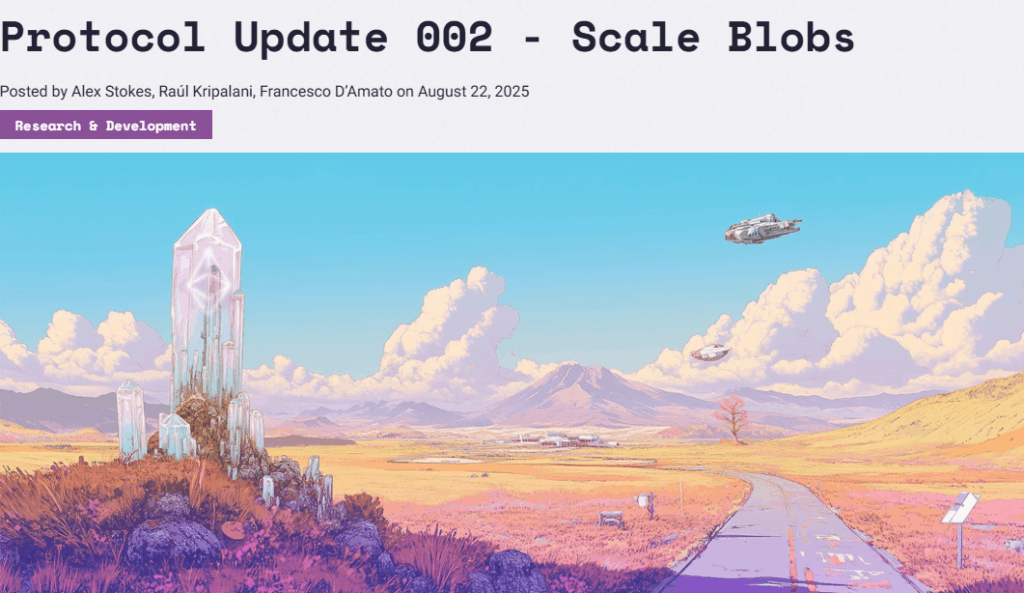
The ETH Foundation released Protocol Update 002, focusing on research and deployment of Distributed Storage Architecture (DAS): PeerDAS, a BPO parameter fork, Glamsterdam network optimizations, and mempool sharding. The goal is to increase data throughput while preserving decentralization and security, thereby reducing costs and improving efficiency for L2s and rollups.
Summary: This Innovation and Tech article analyzes the update’s impact on ETH scalability across six dimensions—overview, PeerDAS, BPO, Glamsterdam, mempool sharding, and next-generation DAS—and lists key milestones and risk factors.
ETH Protocol Update 002 Overview
The official summary presents three main scaling tracks:
- Fusaka introduces PeerDAS, expanding mainnet-reachable blob capacity from a target of 6 per block to 48.
- Adopt a “Blob-Parameter-Only” (BPO) fork that incrementally raises mainnet blob targets and caps as needed.
- Glamsterdam plans to iterate on PeerDAS with more advanced networking techniques to expand further.
At the same time, the team emphasizes that as data scales up, mempool sharding is needed to maintain decentralization and composability.
PeerDAS and Blob Scaling
PeerDAS tightly combines data availability sampling (DAS) with deeper peer-to-peer propagation, enabling ordinary nodes to verify blob availability via sampling. This supports a jump from 6 to 48 blobs per block without significantly raising hardware requirements and substantially increases DA (data availability) supply. Direct effects for ETH include lower L2 submission costs, controllable bandwidth pressure, and improved user fees and confirmation latency; community research also estimates notable gains in UOPS (user ops) and overall throughput under a 48-blob target.
Implications for developers and L2s
For L2 teams, PeerDAS shortens data-submission congestion windows and improves the stability of batching and settlement. For application developers, changes in calldata/blob cost structures on ETH will push more off-state/compression schemes into production, benefiting high-frequency apps (trading, social, gaming).
BPO Fork and Bandwidth Optimization
BPO (Blob-Parameter-Only) is a lightweight fork framework that changes only blob parameters—target, max, baseFeeUpdateFraction, etc.—and pairs them with incremental P2P bandwidth optimizations. This binds the pace of scaling to measured network data, reduces disruption to the consensus/execution layers, and preserves home-node participation.
Governance implications of incremental scaling
Under BPO, client and research teams can “move fast in small steps” in response to mainnet congestion, node bandwidth distribution, and L2 demand—avoiding the risks and coordination costs of one-shot “leap” upgrades.
Glamsterdam: The Next Step for the Network Stack and PeerDAS
The roadmap proposes introducing more advanced networking techniques in Glamsterdam to iterate on PeerDAS—aiming to further improve throughput and propagation stability—and to port Fusaka’s research into the mainnet upgrade path (expected to advance alongside subsequent roadmaps). For ETH, this marks a key transition from research to productized on-chain capability.
Trackable milestones
Watch Fusaka/successor testnets’ blob propagation success rates; client bandwidth/CPU curves; safety margins for targets from 48 upward; and the average per-transaction data cost trend for L2s.

Mempool Sharding
As data volumes grow, distributing blob transactions across shard-specific sub-pools can reduce global broadcast pressure, ease hotspot congestion, and, together with DAS sampling, form a “sharded propagation + sampled verification” synergy—avoiding single-node bottlenecks and preserving open access and anti-censorship traits.
Design highlights
Sound sharding/routing should let nodes make inclusion/forwarding decisions without a global view, while providing cross-shard retransmission and consistency checks to prevent “shard islands.” Research and conference talks have proposed concrete network-layer designs.
Next-Generation DAS: Research Outlook
The research team is evaluating higher-dimensional coding, sampling, and network-coordination schemes to keep increasing blob throughput and lowering verification costs. In the long run, this means offering cheaper, more stable DA for all kinds of rollups without sacrificing validator accessibility—giving solid engineering backing to the “Ethereum as a data layer” narrative.
Risks and Watchpoints
If parameter increases and bandwidth optimizations are not synchronized, some ETH nodes may fall behind or slow sync. PeerDAS deployment must pass multi-client consistency and adversarial-resilience checks to prevent adaptive attacks on sampling. Mempool sharding introduces new routing and consistency complexity that must be validated under strong-adversary models. High-frequency, small BPO upgrades also require tighter coordination across clients and downstream ecosystems. Overall, expansion pacing should be grounded in official testnet metrics, client releases, third-party audits, and observed L2 data-cost curves.
FAQ
Why is this update critical for ETH?
It ties blob scaling and network engineering to a deployable path, preserving ETH’s security and decentralization while freeing capacity for L2s and applications.
How does PeerDAS differ from traditional DAS?
PeerDAS integrates with P2P propagation so nodes can sample-verify without full fetches, supporting higher blob targets while keeping decentralization thresholds practical.
Will BPO upgrades disrupt the ecosystem frequently?
BPO’s small parameter steps reduce “ripple-through” risk. Changes are confined to the blob dimension and decided from measured mainnet data.
When will Glamsterdam show results?
Follow core-client and testnet progress. For ETH users, the clearest signals are falling L2 data fees and congestion indicators.
Will mempool sharding reduce transaction visibility?
The goal is sharded propagation while remaining publicly verifiable, with rebroadcast and cross-shard checks maintaining fair access and consistency.
Key Takeaways
ETH Update 002 anchors three main tracks—PeerDAS, BPO, and Glamsterdam—supported by mempool-sharding research.
PeerDAS targets raising blobs from 6 to 48 per block, directly improving L2 data costs and ETH’s DA supply.
BPO binds scaling to measured network data, minimizing consensus/execution disruption and preserving home-node participation.
Glamsterdam productizes research to serve long-term mainnet throughput upgrades and roadmap progression.
Mempool sharding and next-gen DAS research both point toward a “cheaper, safer” data layer.





